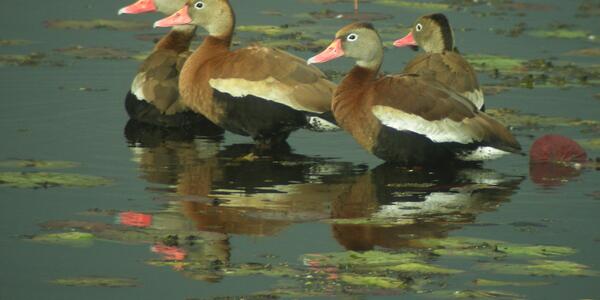
“Notes From the Field” news articles highlight the continued importance of bird banding. This article was contributed by Paul Link with Louisiana Department of Wildlife & Fisheries who began researching Black-bellied Whistling Ducks in 2011, and Pam Garrettson and Joshua Dooley with the U.S. Fish and Wildlife Service, who are assisting with the band-recovery data analyses.
Today, banding allows scientists to investigate bird behavior, migration, lifespans, populations, diseases and levels of environmental contaminants. Information gathered through the North American Bird Banding Program helps inform management and conservation decisions for game and non-game species, such as protecting or restoring habitat, setting hunting regulations and determining plans for human-led development. The North American Bird Banding Program depends on a network of over 10,000 permitted bird banders working in the United States, Canada and Trust Territories. Each year these banders help us add up to 1.2 million new banding records to our century-long dataset.
How do you use bird banding in your research?
We initiated our research in 2011 to answer questions related to the movement ecology and survival of Black-bellied Whistling Ducks in south Louisiana. We started out opportunistically banding this species with standard aluminum butt-end bands for a couple years, but upon realizing encounter rates were much lower than expected, we greatly increased our banding effort. We plan to utilize both live recaptures and dead recoveries to estimate annual survival. Our banding season is February through May, which is an ideal period for captures as the ducks are still gregarious prior to dispersing for nesting. At the onset of our research, we hypothesized that they migrated south to Texas or Mexico during winter, but we hope to use recovery data to better describe movements and habitat use throughout the annual cycle.
Why is your study species so interesting?
Black-bellied Whistling Ducks are found only in the Western Hemisphere. They are more arboreal than other whistling-ducks; they nest primarily in natural tree cavities and readily utilize artificial nest boxes, but also commonly nest on the ground. Unlike most ducks, both the male and female take part in incubation and brood rearing. In North America, this species historically nested mainly along Mexico and south Texas coasts. However, their range began expanding northward mid-20th century, with sightings in Arizona, Louisiana, and Florida by the 1960s. They are a game species with liberal regulations; however, they are only lightly harvested because of their nocturnal nature. Furthermore, traditional waterfowl surveys are inadequate for this species due to low detection probabilities. Many Black-bellied Whistling Ducks congregate in or under trees in urban, suburban, or industrial areas during fall and winter where they are difficult to harvest and/or survey, which makes estimating vital rates such as survival and harvest probabilities more challenging than for most other waterfowl species.
What have you found so far?
Since 2011, we have banded over 40,000 Black-bellied Whistling Ducks and have recaptured >4,200. Interestingly, we have similar numbers of resights versus shot or found dead. The vast majority of those resights are by a single citizen scientist that devotes most evenings for several months each year observing and documenting the ducks’ movements, pair associations, and family status. Roughly 80% of the banded Black-bellied Whistling Ducks are subsequently encountered in Louisiana, with 10% encountered in Mississippi (where we band ~150/year and the previously mentioned citizen scientist resights and reports individuals once per calendar year), 8% in Texas, and 1% or less in Arkansas, Florida, Tennessee, Alabama, and North Carolina. We’ve had just one report of a band recovered in Mexico, from a duck found dead in a grain cargo ship that set sail from the Port of New Orleans days earlier. Thus, most Black-bellied Whistling Ducks appear to be transient residents that concentrate in safe places during the fall and winter and disperse throughout Louisiana during spring and summer to breed. Their apparent survival rates (calculated using only live recapture data) were lower than expected; we are currently incorporating both live and dead recoveries to calculate actual annual survival. We’ve documented multiple large die-offs of up to 3,000 Black-bellied Whistling Ducks due to unintentional poisoning at water treatment and grain handling facilities. Avian cholera outbreaks are also common among this species. An unknown number are also killed via shooting or avicide under agricultural depredation and aircraft bird strike prevention orders. Due to their highly gregarious behavior, Black-bellied Whistling Ducks are particularly susceptible to communicable diseases. Thus, their population seems to self-regulate under conditions of minimal recreational harvest.
Why do you think projects like yours are so important?
This banding project will help us understand the movements and vital rates for a poorly understood, yet very common, waterfowl species along the Gulf Coast, improving population management options. Black-bellied Whistling Ducks are considered a nuisance by many (such as agriculture producers, golf course managers, and aircraft strike prevention personnel); however, amidst long-term declining trends in most resident and migratory waterfowl in Louisiana, waterfowl hunters welcome the sight of this relative newcomer on the landscape.
What are the next steps for your project?
We’ll continue to band a maintenance number of approximately 3,000 individuals per year to explore changes in vital rates amidst a rapidly changing landscape. We are also currently analyzing results from a pilot study utilizing satellite transmitters, as well as working with a transmitter manufacturer to design a miniaturized GPS/GSM device to collect higher quality and greater quantity movement data to better understand their local and long-range movements, use of habitats, nesting and non-breeding ecology, and seasonal survival rates.
The “Notes From the Field” series highlights current banding projects and the continued importance of bird banding and the Bird Banding Lab. Want to see your project featured in a future “Notes From the Field” article? Email Kyra Harvey kharvey@usgs.gov for submission details.
This United States Geological Survey news article "Notes From the Field: Black-bellied Whistling Duck movement ecology and survival study" was originally found on https://www.usgs.gov/news


